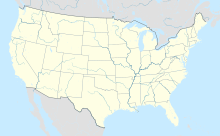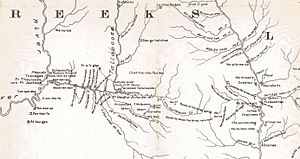Fort Hull facts for kids
Quick facts for kids Fort Hull |
|
|---|---|
| Near Tuskegee, Alabama in United States | |
| Coordinates | 32°21′14″N 85°42′13″W / 32.35389°N 85.70361°W |
| Type | Earthen fort |
| Site information | |
| Owner | Private |
| Controlled by | Private |
| Open to the public |
No |
| Condition | Site on private land |
| Site history | |
| Built | 1814 |
| Built by | Georgia militia |
| In use | 1814–1815 |
| Battles/wars | Creek War |
Fort Hull was a fort made of earth built in 1814. It was located in what is now Macon County, Alabama. This fort was important during the Creek War, a conflict that involved the United States and parts of the Creek tribe.
The United States planned to attack Creek territory from three different directions. Soldiers from Georgia marched west and built Fort Mitchell. After some fighting, they continued their march and built Fort Hull. This new fort was used to store supplies. Fort Hull was only used for a short time and was left empty after the Creek War ended in 1815.
Contents
The Creek War Explained
The Creek War started when some parts of the Creek tribe, called the Red Sticks, decided to fight against the United States. They also fought against other Creek groups who were allied with the Americans. These American-allied Creeks were known as White Sticks.
The Red Sticks were upset because their tribal government was changing. They also didn't like that their traditional lands were being sold. The White Sticks and Red Sticks were already fighting each other before the United States got involved.
When the War of 1812 began, the United States worried that Great Britain might help the Red Sticks. To stop attacks on settlers, the U.S. military started a campaign against the Red Sticks in 1813.
Planning the Attack
After a terrible event called the Fort Mims massacre, the United States planned a big attack. They wanted to hit the main Creek lands from three sides.
- Troops from Tennessee, led by Andrew Jackson, would march south.
- Forces from Georgia, led by John Floyd, would march east.
- Soldiers from the southwest, led by Ferdinand Claiborne, would march north.
General Floyd and his Georgia troops, along with allied Creeks led by William McIntosh, started their march in late 1813. They crossed the Chattahoochee River and built Fort Mitchell. Floyd's forces kept moving west and fought in the Battle of Autossee. General Floyd was hurt in this battle, and his troops went back to Fort Mitchell.
Building Fort Hull
After resting, getting more supplies, and finding new soldiers, General Floyd left Fort Mitchell on January 17, 1814. He had about 1,100 Georgia soldiers, 600 allied Creeks, and some cannons. They marched west along the Federal Road. Their plan was to build forts along the way to protect their supply lines.
The journey was slow because of recent rains. On January 20, Floyd decided to stop and build a fort. This fort would be the first supply point for his army.
How Fort Hull Was Built
Captain Jett Thomas, an engineer, was in charge of building Fort Hull. The fort was named after Commodore Isaac Hull. We don't have any exact drawings of Fort Hull today. However, it was probably built like other forts on the Federal Road, such as Fort Bainbridge.
It was likely an earthwork, meaning it had walls made of dirt. These walls would have been surrounded by a palisade, which is a fence made of strong wooden stakes. The fort probably had at least one blockhouse (a small, strong fort building), places for officers to live, and a magazine for storing gunpowder. A spring that flowed into Persimmon Creek was used as the fort's water source.
It took four days to build Fort Hull. The construction was slow partly because the soldiers were upset about not having enough food and tools. General Floyd had to give them full food portions again before they finished the fort.
While the fort was being built, Captain John P. Harvey led a raid. He captured Alexander Cornells' daughter and nine runaway slaves. They were brought back to Fort Hull.
Fort Hull's Military Role
On January 25, General Floyd felt the Federal Road was safe enough to travel. He left 100 men at Fort Hull and set out for the Creek town of Tukabatchee. Fort Hull was about 15 miles (24 km) east of Tukabatchee. It was also about 24 miles (39 km) east of another Creek town called Hoitlewaule.
American leaders were worried that Red Stick warriors were gathering in these towns. Floyd's forces were slowed down by obstacles the Red Sticks had placed in the road. This delay made Floyd decide to leave the Federal Road and march north instead. His troops set up a temporary camp called Camp Defiance. Floyd sent the army's tents and cooking tools back to Fort Hull. This decision made many soldiers unhappy.
Battle and Return
On January 27, Red Stick warriors launched a surprise attack on Camp Defiance. This battle became known as the Battle of Calebee Creek. After the fight, Floyd stayed at Camp Defiance until February 1 to care for the wounded and bury the dead.
Because supplies were low and his soldiers' enlistment terms were ending soon, Floyd returned to Fort Hull. Spies warned Floyd that Red Sticks were still in the area and planned to attack Fort Hull. The soldiers were relieved to find seven supply wagons waiting for them at Fort Hull.
Even with new supplies, the soldiers grew impatient as their service terms ended on February 22. On February 16, Floyd decided to march his forces back to Fort Mitchell and release his men from duty.
Later Commanders
After General Floyd left, Colonel Homer V. Milton took command of Fort Hull. Volunteers who stayed at the fort formed new groups. These groups were joined by soldiers from North and South Carolina. A U.S. Army company also arrived. During this time, soldiers from Fort Hull carried out raids on Red Stick camps.
When Milton was in charge, Fort Hull had between 100 and 300 men. This number grew to 600 once the fort had more supplies. This force included the Carolina soldiers, allied Creeks, regular infantry, and four cannons.
It was hard to get supplies to Fort Hull because it was deep in Creek territory. In March 1814, General Graham built Fort Bainbridge on the Federal Road. This new fort made it easier for supply wagons to travel between Fort Mitchell and Fort Hull.
After the Battle of Horseshoe Bend, General Jackson planned to destroy any remaining Red Stick villages. He wanted to gather his forces at Hickory Ground and attack Hoitlewaule using soldiers and supplies from Fort Hull. However, this attack never happened. Colonel Milton then left Fort Hull in March 1814 to build Fort Decatur further west.
After Milton left, only a small number of South Carolina soldiers remained at Fort Hull. Their service ended in July 1814, and they went home. After they left, a hospital steward and a quartermaster sergeant were in charge. Even so, the fort still had ammunition and food.
Fort Hull was no longer used for military purposes after 1815 and was soon abandoned.
After the War
Mail was received at a stop called "Fort Hull" as early as 1818, but there was never a post office there.
Near the fort site, there was once a church and a school named Fort Hull Church and Fort Hull School.
As recently as 1952, a historical marker for the fort was located south of Tuskegee on U.S. Route 80. However, no historical marker exists there today.
Fort Hull Today
The exact location of Fort Hull is not marked and is on private land. The site has been damaged by people looking for old items.




